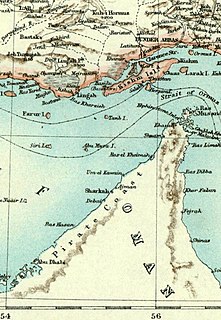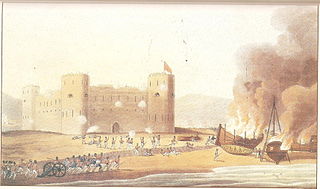
HMS Liverpool was a Royal Navy Endymion-class frigate, reclassified as a fourth rate. She was built by Wigram, Wells and Green and launched at Woolwich on 21 February 1814. She was built of pitch-pine, which made for speedy construction at the expense of durability.
Sheikh Sultan bin Saqr Al Qasimi (1781–1866) was the Sheikh of the Al Qasimi and ruler variously of the towns of Sharjah and Ras Al Khaimah, Jazirah Al Hamra and Rams, all now part of the United Arab Emirates. A dependent of the first Saudi Kingdom, his rule over Ras Al Khaimah ran from 1803–1809, when he was deposed by order of the Saudi Amir and restored in 1820, going on to rule until his death in 1866 at the age of 85. He was Ruler of Sharjah from 1814–1866, with a brief disruption to that rule in 1840 by his elder son Saqr. He was a signatory to various treaties with the British, starting with the General Maritime Treaty of 1820 and culminating in the Perpetual Maritime Truce of 1853, which confirmed Sharjah and Ras Al Khaimah as Trucial States.

Dhayah Fort is an 18th-century fortification in Ras Al Khaimah, United Arab Emirates (UAE). It is the highest hilltop fort in the UAE and was the site of a battle during the Persian Gulf campaign of 1819, when British troops captured the fort after a brief siege.

The Al Qasimi is an Arab dynasty in the Persian Gulf that rules Sharjah and Ras Al Khaimah, today forming two of the seven emirates of the United Arab Emirates. They are one of the longest reigning royal families in the Arabian peninsula.
The Za'ab is an Arab tribe in the Arabian Peninsula
The General Maritime Treaty of 1820 was a treaty initially signed between the rulers of Abu Dhabi, Sharjah, Ajman, Umm Al Quwain, Ras Al Khaimah and Great Britain in January 1820, with the nearby island state of Bahrain acceding to the treaty in the following February. Its full title was, "General Treaty for the Cessation of Plunder and Piracy by Land and Sea, Dated February 5, 1820".
HMS Curlew (1812) was a Royal Navy Cruizer class brig-sloop built by (William) Good & Co., at Bridport and launched in 1812. She served with the Navy for only 10 years. During the War of 1812 she sailed from Halifax and captured several American privateers. Her greatest moment was her role in the 1819 British occupation of Ras al-Khaimah. Curlew was sold in 1822 in Bombay. She then had a 13 or so year career as an opium runner for James Matheson, one of the founders of the firm Jardine Matheson.

Piracy in the Persian Gulf describes the naval warfare that was prevalent until the 19th century and occurred between seafaring Arabs in Eastern Arabia and the British Empire in the Persian Gulf. It was perceived as one of the primary threats to global maritime trade routes, particularly those with significance to British India and Iraq. Many of the most notable historical instances of these raids were conducted by the Al Qasimi tribe. This led to the British mounting the Persian Gulf campaign of 1809, a major maritime action launched by the Royal Navy to bombard Ras Al Khaimah, Lingeh and other Al Qasimi ports. The current ruler of Sharjah, Sultan bin Muhammad Al Qasimi argues in his book The Myth of Piracy in the Gulf that the allegations of piracy were exaggerated by the Honourable East India Company to cut off untaxed trade routes between the Middle East and India.

HCS Aurora, the Honourable East India Company's Ship Aurora, was a sloop-of-war launched at Bombay for the Bombay Marine, the naval arm of the British East India Company (EIC), to protect the trade in the Indian Ocean from pirates. The French captured her in late September 1810, only to have the British recapture her in early December. She returned to the service of the Bombay Marine, assisting the British Government and the Royal Navy in various campaigns in the East Indies and the Persian Gulf. She was still listed on the rolls of the Bombay Marine on 1 January 1828.
Diana was a merchant ship built at Cochin, British India, in 1817. She made one voyage to Britain before the British government hired her to transport troops for a punitive expedition against the pirates of Ras al Khaima. It was in connection with that operation that she wrecked off the coast of Muscat in 1820.
Hannah was launched at Bombay Dockyard in 1811. Shortly after she was launched, she sailed to England on a voyage for the British East India Company (EIC), where her owners sold her to British owners. She engaged in a single-ship action in 1814 in which she repelled an American privateer. She participated as a transport in a punitive expedition in 1819-1820 to Ras al-Khaimah in the Persian Gulf. She was last listed in 1833.

Pascoa was launched at Calcutta in 1816. She was a "country ship", trading around India and between India and China. She was a transport in 1819-20 during the British punitive campaign against the Al Qasimi pirates. She was lost in 1836.
Orient was launched in 1814 at Calcutta. She sailed to England and from then on was based there. She traded with India into the 1830s. She participated in a naval punitive expedition in 1819, and performed four voyages for the British East India Company. From the 1840s she continued to sail widely until she was condemned in 1865 and sold for breaking up.
Cornwall was launched in 1794 as a West Indiaman. In a little more than three years later she had left on the first of three whaling voyages to the Southern Whale Fishery. On her first whaling voyage she captured a Spanish ship and fought off a French privateer. After her third whaling voyage Cornwall returned to the West Indies trade. Around 1817 new owners sent her to India where a Parsi merchant purchased her. She traded in the Persian Gulf and the Indian Ocean, and also participated as a transport in a naval expedition to the Persian Gulf. She was last listed in 1824.

The Persian Gulf campaign of 1819 was a British punitive expedition, principally against the Arab maritime force of the Al Qasimi in the Persian Gulf, which embarked from Bombay, India in November 1819 to attack Ras Al Khaimah. The campaign was militarily successful for the British and led to the signing of the General Maritime Treaty of 1820 between the British and the Sheikhs of what was then known as the 'Pirate Coast', would become known as the 'Trucial Coast' after this treaty and the territory that today comprises the United Arab Emirates.
Hassan bin Rahma Al Qasimi was the Sheikh (ruler) of Ras Al Khaimah from 1814–1820. He was accused by the British of presiding over a number of acts of maritime piracy, an assertion he denied. Despite signing a treaty of peace with the British in October 1814, a punitive expeditionary force was mounted against Ras Al Khaimah in December 1819 and Hassan bin Rahma was removed as Sheikh of Ras Al Khaimah, which he ceded to the British in a preliminary agreement to the General Maritime Treaty of 1820.
Sheikh Rashid bin Humaid Al Nuaimi was the Ruler of Ajman, one of the Trucial States which today form the United Arab Emirates (UAE), from 1816–1838, leading a force of 50 men to take control of the town from members of the Al Bu Shamis tribe who had settled there and also at Al Heera. At the time, Ajman was a dependency of Sharjah. Five years after his establishment at Ajman, the fort was taken by the Darawisha Bedouin who were removed by the action of the Ruler of Sharjah, Sheikh Saqr bin Sultan Al Qasimi.
The H[onourable] C[ompany's] S[hip] Hugh Lindsay was a paddle steamer built in Bombay in 1829 for the naval arm of the British East India Company (EIC) and the first steamship to be built in Bombay. She pioneered the mail route between Suez and Bombay. Hugh Lindsay was lost in the Persian Gulf on 18 August 1865.
HCS Vestal was built in 1809 at the Bombay Dockyard for the Bombay Marine, the naval arm of the British East India Company (EIC). She spent much of her career suppressing commerce raiding in the Persian Gulf. Lastly, she figured in a notable action during the First Anglo-Burmese War. She was subsequently condemned as unserviceable and sold for breaking up.
The Perpetual Maritime Truce of 1853 was a treaty signed between the British and the Rulers of the Sheikhdoms of the Lower Gulf, later to become known as the Trucial States and today known as the United Arab Emirates. The treaty followed the effective subjugation of the Qawasim maritime federation and other coastal settlements of the Lower Gulf by British forces following the Persian Gulf campaign of 1819, a punitive expedition mounted from Bombay which sailed against Ras Al Khaimah, and which resulted in the signing of the General Maritime Treaty of 1820.